Review of the Day: Touch The Sky by Stephanie V.W. Lucianovic WITH Bonus Q&A
I never do this, but sometimes a book is so good that you’ve just gotta double dip. Today I am engaged in the particularly rare twofer: A review AND Q&A with Stephanie V.W. Lucianovic about her upcoming picture book. And you know I don’t do that with just anybody. So here’s how it’s gonna go down.
First, I will review the book.
Second, I will talk to Stephanie about the book.
Now sit back and enjoy one heckuva great title:
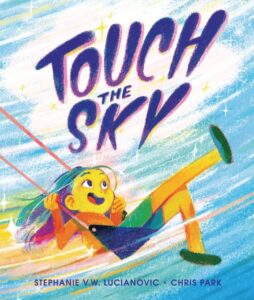
“How do you like to go up in a swing, / Up in the air so blue? / Oh, I do think it is the pleasantest thing / Ever a child can do!”
Robert Louis Stevenson, The Swing
Two opposite things can be true at the same time, when it comes to children’s books. For example, I often tell people that a truly great children’s author can take a subject that’s been done to death a million times before and bring to it something new and striking that’s never been seen before. You can make a truly great book for kids out of the overly familiar. That said, it is also true that sometimes the best titles for children are the ones that suss out a topic or truth about being a kid that has never been captured on the page before. Touch the Sky belongs firmly in the latter category, and for good reason. If you were to approach a children’s librarian, knowledgeable in the field, and ask for the quintessential swing-related picture book on their shelves, what would they hand you? Had you asked me, prior to seeing Ms. Lucianovic’s latest, I would have recommended the board book edition of Robert Louis Stevenson’s The Swing as illustrated by Julie Morstad (long before she became the Kate DiCamillo-illustrating wonder we all know and love today). That book is good, great even, but sedate and serene. Its lyrical read mimics the effects of going up and down on a swing, completely ignoring the complementary thrill and rush. And the difficulty of learning how to pump? Forgettaboutit! For that, you’re going to need Touch the Sky and you’re going to need it stat. A book that truly exemplifies one of those key moments in a child’s life, fated to be forgotten.
ADVERTISEMENT
ADVERTISEMENT
For Vern, the park is the place he tends to go almost every day. Kids all have their favorite places to go in a playground, but for Vern there’s no competition. He’s a swing kid through and through. Usually the most he can do is fling himself onto a swing, belly first, or twist it up and then let go until he’s dizzy. Why? Because Vern doesn’t know how to pump his legs. And unless you know how to do that, you’re grounded. Then one day a girl named Gretchen gives Vern a couple pointers. What follows isn’t instantaneous success or fast learning. Vern wants to give up more than once, but he keeps at it and slowly, slowly, slowly it all starts to come together. Just Vern, the swing, and the sky.
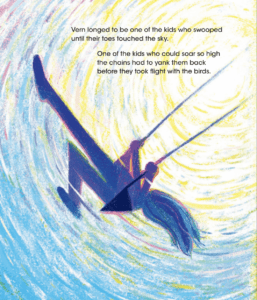
Children are the sole occupants of only a couple spaces in this world, and playgrounds as a rule serve no real purpose aside from existing for kids and kids alone. As a result, they tend to crop up in picture books on a regular basis. Yet for all that, few remain in your brain for very long. I was just sitting here, trying to think up the greatest picture books set in playgrounds, but all I could think of was the aforementioned The Swing and the charming You Go First by Ariel Bernstein, illustrated by Marc Rosenthal. How strange that a place that exerts such a pull on a child’s early life (and occupies their adult caretakers as well) should be so little lauded on the page. Until now.
Speaking of those caretakers, it took me a read or two of this book before I realized that there’s one key component to swinging completely obliterated from the narrative. Which is to say, this title is a parent-free zone. You’re not going to find one of those overaged interlopers spoiling the purely kid-centric narrative here. You have to assume they exist, of course. Vern’s love of swinging high but without the requisite knowledge of how to pump is entirely contingent on some big person giving him a push on a regular basis. But for this book to have the right amount of emotional oomph, Vern needs to learn pumping entirely on his own. That means excluding any well-meaning but ultimately unnecessary grown-ups from the book. Don’t worry. You don’t even miss them.
How to make a truly great picture book? Step One: Fill book with great writing. Tall order, that. If every incipient picture book author was able to conjure up words that were both exquisite and chock full of truth, then it would make the lives of reviewers like myself much harder, I can tell you. There is a moment in every book, and it doesn’t matter if I’m talking about titles for babies or the geriatric, when the reader falls in love. It might not be on the first read. It might not even be on the fifth or fiftieth, but when it happens you will defend that book’s honor to the end of your dying days. For me, that moment happened on page ten with the appearance of Gretchen. The book explains that Vern only knew her because of her mom.
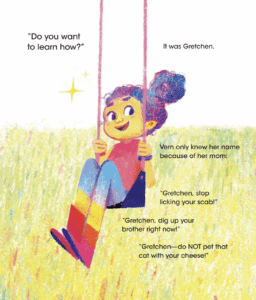
“Gretchen, stop licking your scab!”
“Gretchen, dig up your brother right now!”
“Gretchen – do NOT pet that cat with your cheese!”
That sequence is doing the duty of making you fall in love with the book, sure, but you’re also now firmly in the pro-Gretchen camp and you would follow her lead wherever she might go. Creative writing teachers should use this sequence with up-and-coming authors to show them how to create an instant rapport with an audience.
But clever wordplay is only half the battle. Lucianovic also has to nail home the whole concept of learning something new and hard. In doing so, she has to avoid The Elmo Effect. That’s a term I just made up. You see, once I was watching Sesame Street with my kids and it was a sequence where Elmo wanted to learn to play some kind of an instrument. This being contemporary Sesame Street (i.e. shorter than it was when I was a kid) the sequence plays out like this: Elmo tries and fails. Elmo tries and fails. Elmo tries and succeeds! The Elmo Effect. And I hate this sequence. As anyone will tell you, the odds of learning something new on a third try, while not impossible, is pretty darn low. But picture books, like 21st century Sesame Street sequences, are pressed for time. This book clocks in at a mere 32 pages, so it was enormously gratifying to find Lucianovic not only shows Vern’s frustrations (“Giving up felt easier than trying again”, “He could get off the swing now. Gretchen would never know he gave up”) but also just the sheer amount of work he has to put into the learning. Even when he gets it, it isn’t slam-bang-whoopsie-doo-it’s-a-miracle all at once. Competence increases at its own steady rate. Beautifully done.
One of these days I’m going to shake up my normal writing format and mention the art right at the start of my reviews rather than near the end. That day, alas, is not today but not for a lack of respect for what illustrator Chris Park is doing here. Glance at the publication page and you read that the art of this book was created with “mixed media”, an all-encompassing term that tells you diddly over squat about Park’s process. That’s actually okay, though, since I’m a lot more interested in how Park managed to take what could have been an average playground book and made it, frankly, gorgeous. His medium resembles that of pastels and crayons (which are probably digital) but it’s his colors that set this whole enterprise apart. Specifically Vern’s hair. It’s long and luscious (still a rarity in books about boys) and filled with all these different blues, purples, and pinks. Gretchen’s hair? It seems to radiate purples and pinks almost from the inside out. Then you start looking at how Park shakes up his angles and the nuances of each page. Look at that shot of Vern on a swing from underneath, his body dark against the blinding light of the sun. Now look at the body language at play. The way Vern’s feet close in on themselves when Gretchen talks to him for the very first time. There’s even this fascinating sequence where the background becomes dark, and the scenes of Vern’s attempts become windows and even blobs. What could have been rote, nay, is almost REQUIRED by some books to BE rote, is made exemplary and magical thanks to one illustrator’s finesse.
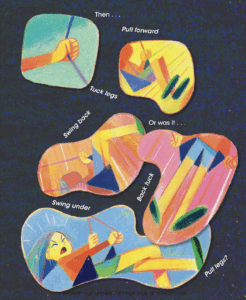
The premise is good, the art fantastic, and the writing stellar but that could all be said of a lot of books. A truly great picture book needs that one extra added element to be stirred into the mix. That thing that lifts it, just one more step, above the hoard of hundreds of picture books published every year. In short, it needs heart. Real heart, TRUE heart. Touch the Sky has that heart in a single moment near the end of the book. Vern, at long last, has learned to pump and is filled to brimming with that knowledge. Now comes the moment of truth. So many kids (hell, adults too) when they have learned something new, will use that knowledge to lord it over the ones who still don’t know. In some alternate universe there is a version of this book where Vern turns to the envious little kid at the end of the book and rubs his newly acquired pump knowledge in that child’s face. Not this book. When the kid notes how good Vern now is, the response is an immediate, “It feels hard until you get it, and then it’s not . . . Do you want to learn how?” We never get to hear the first child’s response, but I feel like Park’s endpapers, filled to the brim with words like “PUMP”, “AGAIN”, “SKY”, “TUCK”, “TIP”, and more, are the actual answer.
Yeah, so I like it. Think it’s pretty good. I also think it’s a great example of all these different elements working together in tandem in just the right order and sequence. Humor and heart. Beautiful art and a smart text. A familiar concept but unfamiliar in a picture book until now. Memorable writing. All told, there are loads of picture books coming out every day that are perfectly fine. Completely decent. Downright nice. This book is not one of them. This book is better than those books. It has accessed, by whatever means, the magic required to make a title go from merely good to great. Best that you do a kid a favor and read it to them ASAP. They’ll be glad you did. You’ll be glad you did.
On shelves May 7th.
Source: E-galley sent from publisher for review.
And now, a couple words from Stephanie herself . . .
Betsy Bird: Stephanie! How the heck are you? And this book! Daaaang. It’s legitimately one of my favorites of the year. I’m downright baffled when I realize that I have read thousands upon thousands of picture books before and not a single one has ever been about learning to pump your legs on the swing. I can probably guess your answer to this, but can you give us the origin story of this book?

Stephanie V.W. Lucianovic: Betsy! Always a joy to talk to you because you ask the most interesting interview questions!
I’m so thrilled you feel that way about TOUCH THE SKY — I’m definitely not one to disagree! It *is* kind of wild that no other book has tackled this subject, which I put down to being seen as a “small moment” in a kid’s physical life. Not that the emotional impact is small, by any means, more that I think it doesn’t seem as HUGE to adult editors as jumping off a diving board or staying upright on a bike. (In fact selling it, we got a lot of “not special enough to break this out in the market” kind of passes, which, hello? There aren’t ANY other books on this subject!)
Another reason for the lack of picture books on swinging is that it is — as I personally and physically discovered — incredibly difficult to try and describe in writing how one gets their body to contort and flex and crunch with the coordination necessary to gain that crucial momentum to keep going.
As for the idea: I mean, like so many of my books, OF COURSE my original inspiration came from my own children going through the pump phase themselves. It’s not that I had forgotten my own struggles with it when I was their age, it’s just that I really didn’t think about it as an adult until I was trying to teach my own kids how to do it. My husband pointed out to me that it’s incredibly difficult to remember a time when we didn’t know something. Like, once you learn how to pump on a swing, it’s really hard to remember what it was like not to know how.
In this case, my youngest was taking longer than his older brother did to figure out the necessary coordinations, and I was trying in vain to explain it to him — both in words and physically. He was frustrated because friends very much took the attitude of, “Come on — it’s SO easy!” Which, yes, it is easy when you finally get it, but not before! It all got me thinking of all the great memories I had on swing sets as a kid: underdogs, leaps from the swings and landing on your feet, how those black rubber seats burned your butt in the summer, and even swinging with a high school sweetheart at dusk in a particular park. I could go on and on, but the long and short of it is: whenever I realize there’s so much emotion steeped in a certain, iconic childhood moment, that’s when I want to write it down for me, and then turn it into something for everyone.
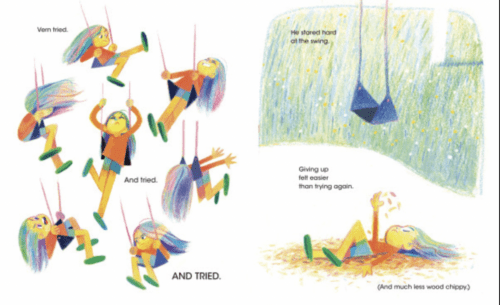
BB: One thing I particularly appreciated about this book was that it avoids what I call The Elmo Effect. Which is to say, it doesn’t show a character failing one or two times and then being an immediate pro. Vern has to try on his own repeatedly and even when he starts to get it, it’s super slow. Success is not instantaneous. How important was it to you to make sure that was the case with this story?
SVWL: That part was incredibly important to me because none of these things — diving off a diving board, riding a bike, learning how to pump — happens in one day. It takes time and effort and it includes very real failures and very real frustration. I never liked books that took difficult things and made them out to be so easy. As a kid, they made me feel both inadequate and also lied to. I never want to lie to kids about the important things in my books — I want to validate their feelings, which are often quite complex. Kids can want to learn how to pump but also not want to work on it if it doesn’t come easy to them. And they can feel shame for not getting it right away and impatience and frustration with themselves and others during the entire process.
BB: The sentence “Gretchen stop licking your scab” may already be my favorite of the year. And I love the names you gave these characters. Gretchen. Vern. Why these particular names for this particular book?
SVWL: Me and Beatrice Alemagna, we get real with the scabs! I’ll tell you a secret, that particular sentence is something I’ve actually said to one of my children. Until my kids were about 8, I kept careful journals about all the crazy things they said or did, and those notes included things I had to say to them. “Don’t pet that cat with your cheese” was another sentence I uttered in real life that also made it into the book.
As for the character names: they aren’t common names these days, are they? I do think that makes them really stand out for people, but to answer your question, I named them for my parents. They are both in their 80s, and it tickled me to stick them in a story about kids in a park.
BB: Ahhhh, I suspected something like that! Now I don’t think there’s a soul alive who can’t relate to the idea that it’s easier to just give up and lie in the wood chips under a swing than it is to try something difficult again and again. It’s one thing to try to depict frustration on the page and something else entirely to do so well. When you were writing this, how many drafts did it go through to get it just right?
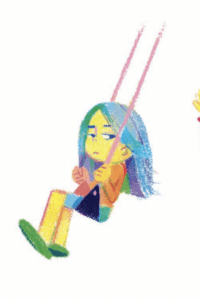
SVWL: I frequently lose count of my drafts because I tend to overwrite a draft rather than save it as a new draft. However, this one looks like it went through at least seven drafts before it was on submission to editors. My first draft had Vern getting frustrated, but not lying-in-the-woodchips-giving-up frustrated. By the second draft, I had teased that part out to last a little bit longer. However, I didn’t have the part about Gretchen never knowing if Vern were to give up until the 5th draft, and I feel like that part is so necessary to fully showcase how we feel when we want to give up. Like, no one’s watching and keeping track, so we can just a walk away, right?
BB: Well, for that matter, how different is this book from the very first draft? Did you have to take out anything you liked?
SVWL: I’d say it’s pretty different from the first draft, but it’s much stronger. I rushed the ending a bit in the very first draft, and really didn’t spend too much time on the part where he’s learning the physical lesson of pumping. I was afraid to lean into that because I thought it wouldn’t have enough action and drag the pacing down.
Two lines that I really liked but had to lose somewhere along the way were:
“Herb itched wood chips out of his shorts and tried again” and “Anastasia ran backwards until her tip toes were barely grasping the ground.”
I can’t remember when or why they came out, but it was probably about us leaning into brevity once we were working with the art. So much can be trimmed when you get to that stage. Also, those original names — Herb and Anastasia — got changed because we felt they might be difficult names to read aloud. But I still think Herb’s a really funny/old fashioned name for a kid and I would like to use it in another book someday.
But make no mistake, I wasn’t at all heartbroken by any of the changes. In fact, I had to compare drafts just now in order to remember them! I’ve certainly gotten past that writing hurdle where killing your darlings is an emotional wrench.
BB: I’m not sure what burnt sacrifices you offered up to the Illustration Gods, but congrats on getting paired alongside artist Chris Park! Did you know Chris’s work before this? How do you feel about the final product?
SVWL: Words fail when I talk about Chris’ art. I was not familiar with his work before, but when my team at Carolrhoda/Lerner suggested him, I was all-in and completely on the edge of my seat to see what he would do with the story. As you can imagine, I was NOT disappointed in the least.
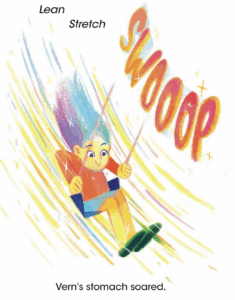
One of my favorite parts about working on this particular book is that the picture book team at CarolRhoda/Lerner Books are some of the best people in publishing. Ever. My editor, Carol Hinz, and the designer, Danielle Carnito, have generously involved me in every aspect of this book’s creation from day one. As a text-only author, I don’t always get to see or have input on how the art and design come about. In this case, I was given the opportunity to react to everything! However, I don’t think I was much help in the end because my only reactions were: “I love this!” and “This is amazing, no notes!” It was the truth, though, and the final product fills me with such joy and amazement. I have never seen a picture book look like this one, and I really hope to work with Chris on many more books.
BB: You’re busy as all get out, but I gotta ask. What do you have coming out next (or even in tandem) for us?
SVWL: Hah! You’re sneaky with that “in tandem” bit, because I think you know that by the time this Q&A goes live, my verse novel about a kid dealing with distance learning during the early days of the pandemic will be out. That particular book, HUMMINGBIRD SEASON, is very important to me because it’s another one of those stories where I want kids to feel seen and to know that their experiences were very real and very lousy. I also want them to have the space and moment to discuss them since so many adults were very “business as usual!” when life started to return to a ew kind of normal. But I also know there are kids who were too young to really remember the pandemic and I hope that HUMMINGBIRD SEASON serves as a sort of emotional record of history for everyone.
Additionally, coming out in 2025, I have an ADORABLE book about a zombie boy who makes a pet out of one of the baby brains his parents raise on their farm and another book about the anxiety a child feels during a lockdown drill at his school. The zombie book will be published by Bloomsbury and illustrated by the amazing Laan Cham and the lockdown drill book is coming out with Random House Kids and will be illustrated by Gabrielle Grimard, an award-winning French-Canadian artist. I also have an unannounced picture book that I can’t say much about, but I will tell you that it was the FIRST EVER picture book I attempted to write, and ten years later it will actually see the light of day.
Big thanks to Stephanie for answering my questions and to Lindsay Matvick and the team at Lerner for helping to put all of this together. Touch the Sky is out May 7th in fine bookstores and libraries everywhere.
Filed under: Best Books, Best Books of 2024, Interviews, Review 2024, Reviews
About Betsy Bird
Betsy Bird is currently the Collection Development Manager of the Evanston Public Library system and a former Materials Specialist for New York Public Library. She has served on Newbery, written for Horn Book, and has done other lovely little things that she'd love to tell you about but that she's sure you'd find more interesting to hear of in person. Her opinions are her own and do not reflect those of EPL, SLJ, or any of the other acronyms you might be able to name. Follow her on Twitter: @fuseeight.
ADVERTISEMENT
ADVERTISEMENT
SLJ Blog Network
Name That LEGO Book Cover! (#53)
Exclusive: Vol. 2 of The Weirn Books Is Coming in October | News
Fighting Public School Book Bans with the Civil Rights Act
North Texas Teen Book Festival 2024 Recap
ADVERTISEMENT

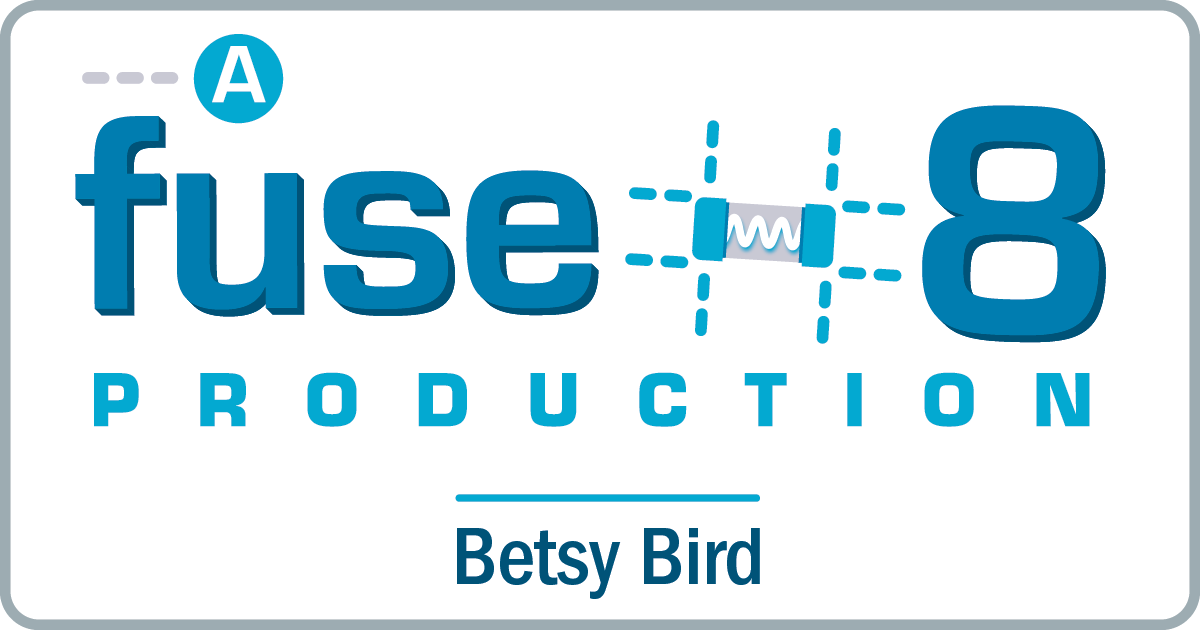

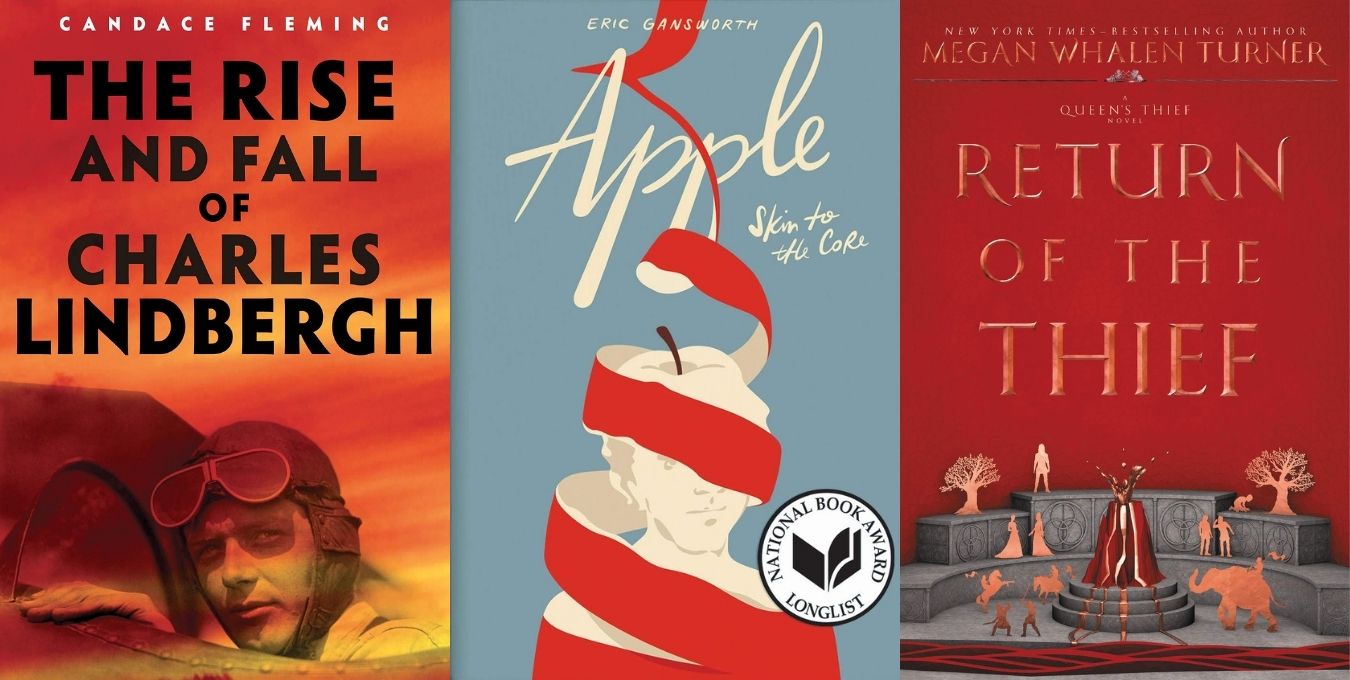
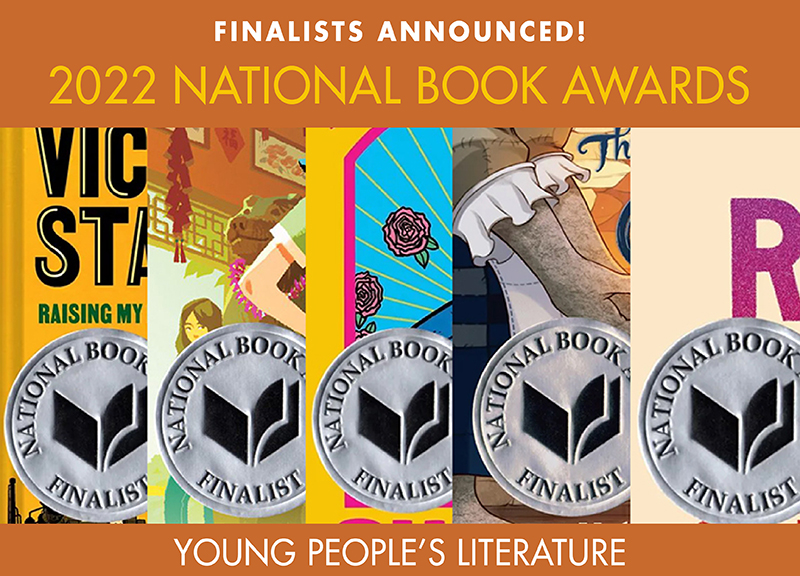
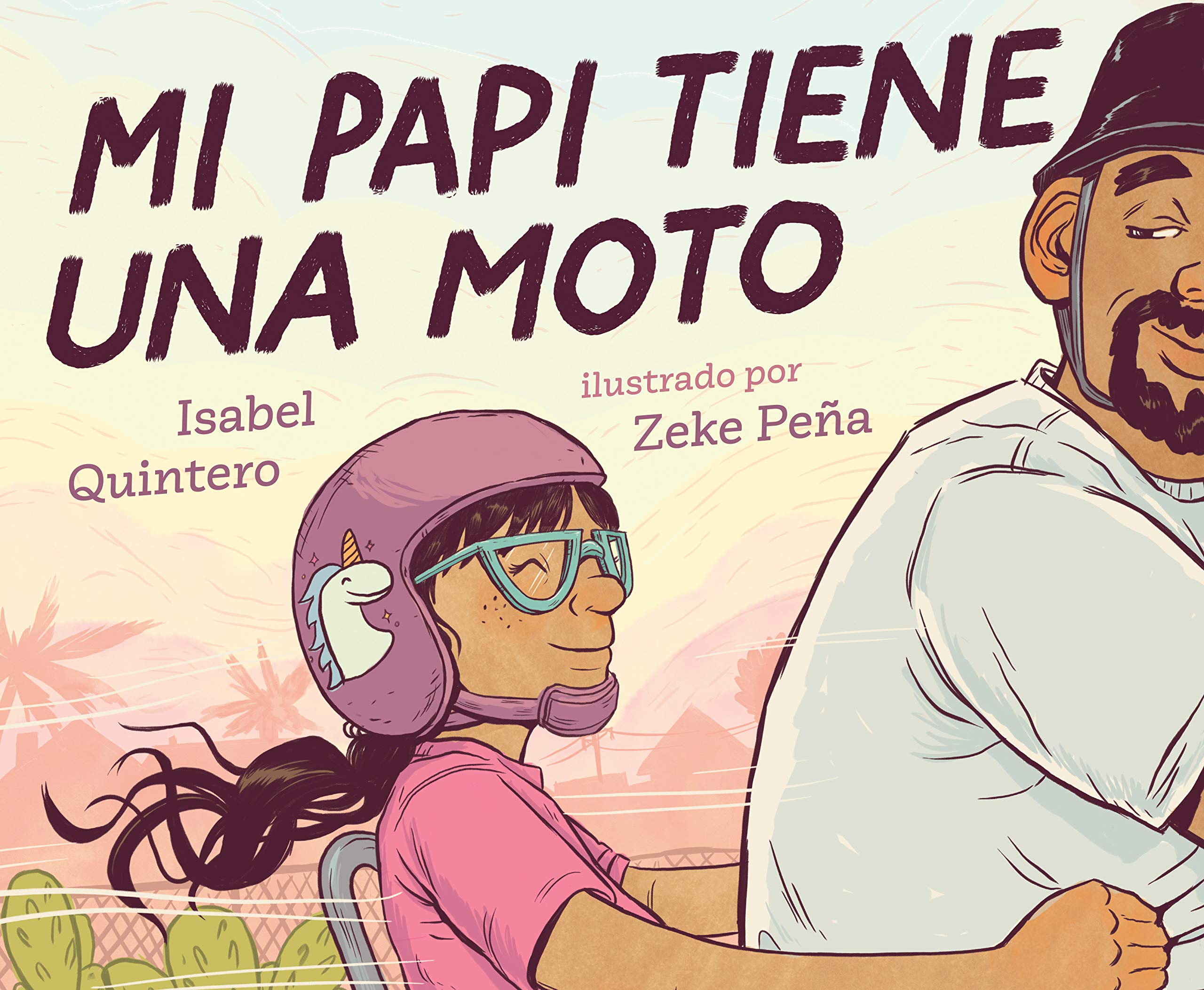
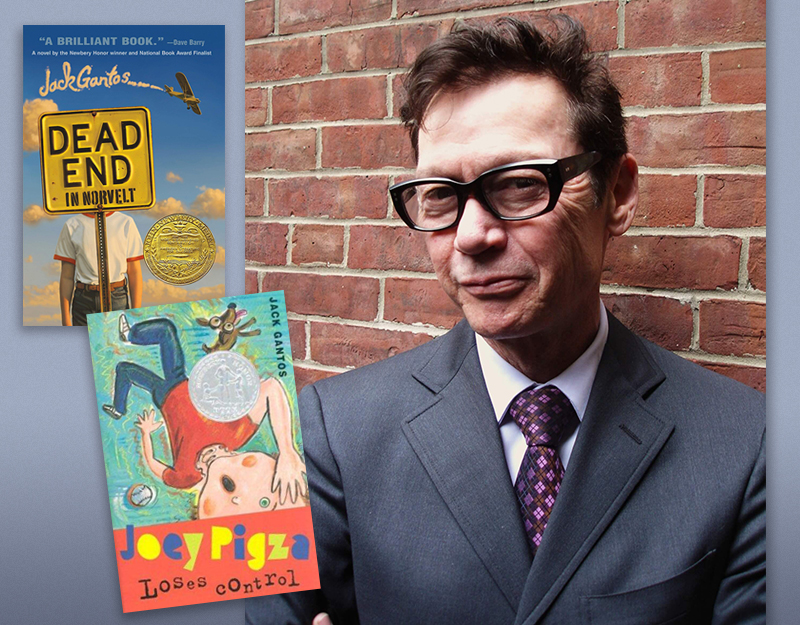
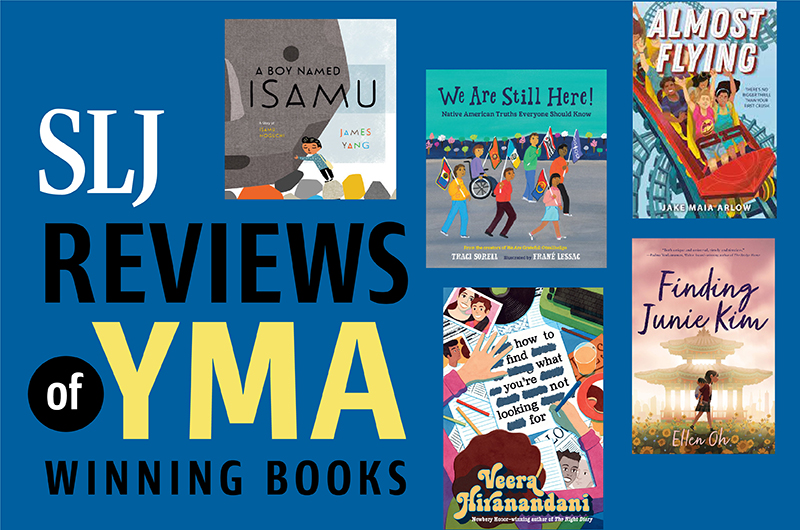
I’ll make a special point of reading this book just because of “Gretchen, stop licking your scab.” Your favorite sentence of the year, Betsy? How about my favorite sentence EVER in a children’s book. I immediately thought “oh, my, God, is this what I missed choosing never to be a mom?” I also could not believe “Don’t pet that cat with your cheese” and would like to suggest Stephanie consider publishing a book of her collection of these one liners . . . illustrated or not!
I’m 78, as you know, but memories of the sensation of swinging as high as possible while pumping my legs bring back the profound pleasure of that experience. I wonder if I’m brave enough today to seek out swings in a park somewhere and give it a try?????? Would someone call the police?
Thanks for a great review and interview. . . . a wonderful way to begin my day. Later my golden retriever and I will have Read to a Dog experience in two public libraries. I’ll be sharing today’s post with the librarians.
Thank you so much for this amazing (and unexpected!) review, Betsy. For your viewing pleasure, here’s a little insight into Chris’ process + medium when he did our cover reveal: https://www.instagram.com/p/Cyi9jVDLEHU/
Yep, you had me at scab. Can’t wait to read it! But I have to say that Julie Fogliano’s MY BEST FRIEND, illustrated by Jillian Tamaki, is a memorable playground book.
Oh yes, oh yes!! That book was brilliant as well. I’m beginning to think we should amass a Best Playground Picture Books list.
I’m so excited to see this book after reading this review. “Gretchen, stop licking your scab.” Outstanding!
I’m also a big fan of Chris Park’s work and am lucky to have a picture booking coming with him November 1 called So Cold!